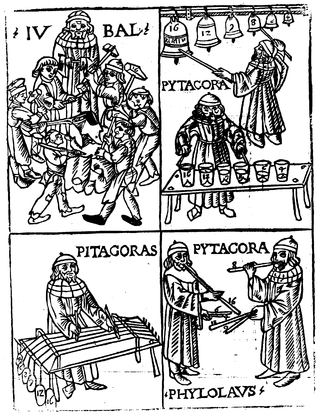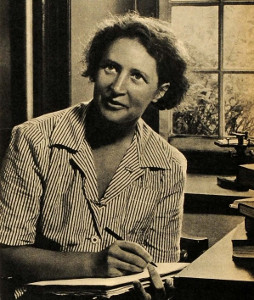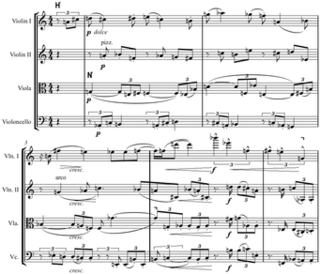Related Research Articles

Pierrot is a stock character of pantomime and commedia dell'arte, whose origins are in the late seventeenth-century Italian troupe of players performing in Paris and known as the Comédie-Italienne. The name is a diminutive of Pierre (Peter), via the suffix -ot. His character in contemporary popular culture — in poetry, fiction, and the visual arts, as well as works for the stage, screen, and concert hall — is that of the sad clown, often pining for love of Columbine, who usually breaks his heart and leaves him for Harlequin. Performing unmasked, with a whitened face, he wears a loose white blouse with large buttons and wide white pantaloons. Sometimes he appears with a frilled collaret and a hat, usually with a close-fitting crown and wide round brim and, more rarely, with a conical shape like a dunce's cap.

Music theory is the study of the practices and possibilities of music. The Oxford Companion to Music describes three interrelated uses of the term "music theory": The first is the "rudiments", that are needed to understand music notation ; the second is learning scholars' views on music from antiquity to the present; the third is a sub-topic of musicology that "seeks to define processes and general principles in music". The musicological approach to theory differs from music analysis "in that it takes as its starting-point not the individual work or performance but the fundamental materials from which it is built."

Dreimal sieben Gedichte aus Albert Girauds "Pierrot lunaire", commonly known simply as Pierrot lunaire, Op. 21, is a melodrama by Arnold Schoenberg. It is a setting of 21 selected poems from Albert Giraud's cycle of the same name as translated into German by Otto Erich Hartleben. The work is written for reciter who delivers the poems in the Sprechstimme style accompanied by a small instrumental ensemble. Schoenberg had previously used a combination of spoken text with instrumental accompaniment, called "melodrama", in the summer-wind narrative of the Gurre-Lieder, which was a fashionable musical style popular at the end of the nineteenth century. Though the music is atonal, it does not employ Schoenberg's twelve-tone technique, which he did not use until 1921.

Vaginal Davis is an American performing artist, painter, independent curator, composer, filmmaker and writer. Born intersex and raised in South Central, Los Angeles, Davis gained notoriety in New York during the 1980s, where she inspired the Bushwick neighborhood of Brooklyn's prevalent drag scene as a genderqueer artist. She currently resides in Berlin, Germany.

Anticipation is an emotion involving pleasure or anxiety in considering or awaiting an expected event. Anticipatory emotions include fear, anxiety, hope and trust. When the anticipated event fails to occur, it results in disappointment or relief.
The New York UniversitySteinhardt School of Culture, Education, and Human Development is the school of education of New York University. The school was founded as the School of Pedagogy in 1890. Prior to 2001, it was known as the NYU School of Education.
Paul Seiko Chihara is an American composer.

Paula Robison is a flute soloist and teacher.
In music, voice crossing is the intersection of melodic lines in a composition, leaving a lower voice on a higher pitch than a higher voice. Because this can cause registral confusion and reduce the independence of the voices, it is sometimes avoided in composition and pedagogical exercises.
Philosophy of music is the study of "fundamental questions about the nature of music and our experience of it". The philosophical study of music has many connections with philosophical questions in metaphysics and aesthetics. The expression was born in the 19th century and has been used especially as the name of a discipline since the 1980s.
Stanford University has many centers and institutes dedicated to the study of various specific topics. These centers and institutes may be within a department, within a school but across departments, an independent laboratory, institute or center reporting directly to the dean of research and outside any school, or semi-independent of the university itself.

Susanne Katherina Langer was an American philosopher, writer, and educator known for her theories on the influences of art on the mind. She was one of the earliest American women to achieve an academic career in philosophy and the first woman to be professionally recognized as an American philosopher. Langer is best remembered for her 1942 book Philosophy in a New Key which was followed by a sequel Feeling and Form: A Theory of Art in 1953. In 1960, Langer was elected a Fellow of the American Academy of Arts and Sciences.
John Torreano is an American artist from Michigan. He is currently clinical professor of studio art at the Steinhardt School of Culture, Education, and Human Development at New York University. Torreano is known for utilizing faceted gems in a variety of mediums in order to create "movement oriented perception" in his works. Artist Richard Artschwager described Torreano's works as "paintings that stand still and make you move."

Maria Baptist is a German musician and professor.

Pierrot lunaire: rondels bergamasques is a cycle of fifty poems published in 1884 by the Belgian poet Albert Giraud, who is usually associated with the Symbolist Movement. The protagonist of the cycle is Pierrot, the comic servant of the Italian Commedia dell'Arte and, later, of Parisian boulevard pantomime. The early 19th-century Romantics, Théophile Gautier most notably, had been drawn to the figure by his Chaplinesque pluckiness and pathos, and by the end of the century, especially in the hands of the Symbolists and Decadents, Pierrot had evolved into an alter-ego of the artist, particularly of the so-called poète maudit. He became the subject of numerous compositions, theatrical, literary, musical, and graphic.

In music, Hauptstimme or Hauptsatz is the main voice, chief part; i.e., the contrapuntal or melodic line of primary importance, in opposition to Nebenstimme. Nebenstimme or Seitensatz is the secondary part; i.e., a secondary contrapuntal or melodic part, always occurring simultaneously with, and subsidiary to, the Hauptstimme. The practice of marking the primary voice within the musical score/parts was invented by Arnold Schoenberg.

Jordan Randall Smith is an American conductor, arts entrepreneur, and percussionist. He is the music director of Symphony Number One and conductor of the Hopkins Concert Orchestra at Johns Hopkins University. He was also a Visiting assistant professor of Music and Director of Orchestra at Susquehanna University.
Vincenzo Caporaletti is an Italian musicologist known for devising audiotactile formativity theory.

Aliza Shvarts is an artist and writer who works in performance, video, and installation. Her art and writing explore queer and feminist understandings of reproduction and duration, and use these themes to affirm abjection, failure, and "decreation". Simone Weil's idea of decreation has been described as "a mystical passage from the created to the uncreated" and "a spiritual exercise of mystical passage: across a threshold, from created to uncreated".
Cultural references to Pierrot have been made since the inception of the character in the 17th century. His character in contemporary popular culture — in poetry, fiction, and the visual arts, as well as works for the stage, screen, and concert hall — is that of the sad clown, often pining for love of Columbine, who usually breaks his heart and leaves him for Harlequin. Many cultural movements found him amenable to their respective causes: Decadents turned him into a disillusioned foe of idealism; Symbolists saw him as a lonely fellow-sufferer; Modernists converted him into a Whistlerian subject for canvases devoted to form and color and line.
References
- ↑ Sachße, Susanne; Bachmann, Paulina; Vega, Luizo; Ivanenko, Maria (2014-05-24), Pierrot Lunaire , retrieved 2017-05-19
- ↑ "Roger Mathew Grant - Faculty, Wesleyan University". www.wesleyan.edu. Retrieved 2017-05-19.
- ↑ Wakefield, Tanu (2017-01-30). "Stanford Humanities Center fellow Q&A: Roger Grant on affect theory". Stanford Humanities Center. Retrieved 2021-02-19.
- ↑ "The Magic Flute - 80 Washington Square East Galleries - NYU Steinhardt". steinhardt.nyu.edu. Retrieved 2017-05-19.
- ↑ Pierrot Lunaire (2014) - IMDb , retrieved 2021-02-18